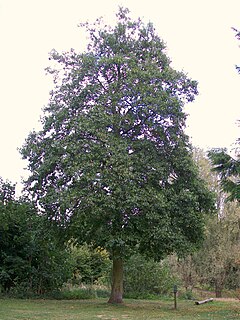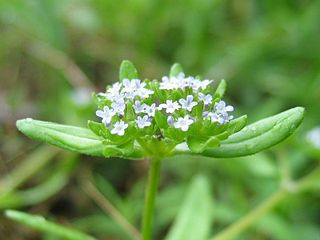
Cytisus is a genus of flowering plants in the family Fabaceae, native to open sites in Europe, western Asia and North Africa. It belongs to the subfamily Faboideae, and is one of several genera in the tribe Genisteae which are commonly called brooms. They are shrubs producing masses of brightly coloured, pea-like flowers, often highly fragrant. Members of the segregate genera, Calicotome, Chamaecytisus, and Lembotropis are sometimes included in Cytisus.

Matthiola is a genus of flowering plant in the mustard family Brassicaceae. It is named after Italian naturalist Pietro Andrea Mattioli (1501–1577). The genus contains about 50 species of annual, biennial and perennial herbaceous plants and subshrubs. Many are cultivated for their heavily scented, colorful flowers.

Alnus cordata, the Italian alder, is a tree or shrub species belonging to the family Betulaceae, and native to the southern Apennine Mountains and the north-eastern mountains of Corsica. It has been introduced in Sicily, Sardinia, and more recently in Central-Northern Italy, other European countries and extra-European countries, where it has become naturalised.

Fumaria is a genus of about 60 species of annual flowering plants in the family Papaveraceae. The genus is native to Europe, Africa and Asia, most diverse in the Mediterranean region, and introduced to North, South America and Australia. Fumaria species are sometimes used in herbal medicine. Fumaria indica contains the alkaloids fuyuziphine and alpha-hydrastine. Fumaria indica may have anti-inflammatory and analgesic potential.

Jacobaea is a genus of flowering plants in the tribe Senecioneae and the family Asteraceae. Its members used to be placed in the genus Senecio, but have been separated into the segregate genus Jacobaea on the basis of molecular phylogenetics in order to maintain genera that are monophyletic.

Valerianella is a genus of plant in family Caprifoliaceae. Many plants of this genus are known by the common name corn salad or cornsalad, although that name most often refers to Valerianella locusta.

Filago is a genus of plants in the sunflower family, native from Europe and northern Africa to Mongolia, Nepal, and Macaronesia. They are sometimes called cottonroses or cudweeds.

Doronicum corsicum is a species of the genus Doronicum and the family Asteraceae. some authors have regarded the species as belonging to either Arnica or Aronicum. It is a rare plant that has been found only on the Island of Corsica in the Mediterranean.

Anthemideae is a tribe of flowering plants in the family, Asteraceae, and the subfamily Asteroideae. They are distributed worldwide with concentrations in central Asia, the Mediterranean Basin, and southern Africa. Most species of plant known as chamomile belong to genera of this tribe.

Adenocarpus is a genus of flowering plants in the family Fabaceae. It belongs to the subfamily Faboideae. The plants are broom-like shrubs with bright yellow flowers. The genus is native to Macaronesia, Portugal and southern Spain, and three species are endemic to the western Canary islands where they are known by the common name Codeso.

Bigelowia is a genus of North American flowering plants in the family Asteraceae, native to the United States.
Arrowsmithia is a genus of flowering plants in the daisy family, Asteraceae.

Eumorphia is a genus of African flowering plants in the daisy family. It has white flowers.

Leptocarpha is a genus of flowering plants in the family Asteraceae.
Marasmodes is a genus of South African shrubs in the chamomile tribe within the daisy family.
Micractis is a genus of African flowering plants in the family Asteraceae.
Stilpnogyne is a genus of flowering plants in the groundsel tribe within the sunflower family.
Pyrilla perpusilla, commonly known as the sugarcane planthopper, is a planthopper in the family Lophopidae. It is native to Asia where it feeds on grasses and other plants and is a major pest of sugarcane and sorghum.

Myagrum, muskweed or musk weed, is a genus of flowering plants in the family Brassicaceae. It has only one species, Myagrum perfoliatum, native to Europe and the Middle East, and an introduced weed in North America, South America, Australia and other places in Asia. It is sister to Isatis.

Himantoglossum robertianum is a species of flowering plant in the orchid family (Orchidaceae) native to the Mediterranean Basin.















